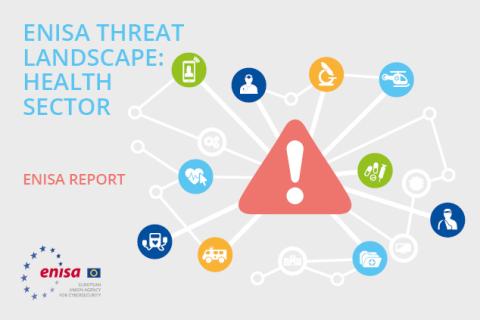The European Union Agency for Cybersecurity (ENISA) releases today its first cyber threat landscape for the health sector. The report found that ransomware accounts for 54% of cybersecurity threats in the health sector.
The comprehensive analysis maps and studies cyberattacks, identifying prime threats, actors, impacts, and trends for a period of over 2 years, providing valuable insights for the healthcare community and policy makers. The analysis is based on a total of 215 publicly reported incidents in the EU and neighbouring countries.
Executive Director of the European Union Agency for Cybersecurity (ENISA), Juhan Lepassaar, said: “A high common level of cybersecurity for the healthcare sector in the EU is essential to ensure health organisations can operate in the safest way. The rise of the covid-19 pandemic showed us how we critically depend on health systems. What I consider as a wake-up call confirmed we need to get a clear view of the risks, the attack surface and the vulnerabilities specific to the sector. Access to incident reporting data must therefore be facilitated to better visualise and comprehend our cyber threat environment and identify the appropriate mitigation measures we need to implement.”
The findings
The report reveals a concerning reality of the challenges faced by the EU health sector during the reporting period.
- Widespread incidents. The European health sector experienced a significant number of incidents, with healthcare providers accounting for 53% of the total incidents. Hospitals, in particular, bore the brunt, with 42% of incidents reported. Additionally, health authorities, bodies and agencies (14%), and the pharmaceutical industry (9%) were targeted.
- Ransomware and data breaches. Ransomware emerged as one of the primary threats in the health sector (54% of incidents). This trend is seen as likely to continue. Only 27% of surveyed organisations in the health sector have a dedicated ransomware defence programme. Driven by financial gain, cybercriminals extort both health organisations and patients, threatening to disclose data, personal or sensitive in nature. Patient data, including electronic health records, were the most targeted assets (30%). Alarmingly, nearly half of all incidents (46%) aimed to steal or leak health organisations' data.
- Impact and lessons learned by the COVID-19 Pandemic. It is essential to note that the reporting period coincided with a significant portion of the COVID-19 pandemic era, during which the healthcare sector became a prime target for attackers. Financially motivated threat actors, driven by the value of patient data, were responsible for the majority of attacks (53%). The pandemic saw multiple instances of data leakage from COVID-19-related systems and testing laboratories in various EU countries. Insiders and poor security practices, including misconfigurations, were identified as primary causes of these leaks. The incidents serve as a stark reminder of the importance of robust cybersecurity practices, particularly in times of urgent operational needs.
- Vulnerabilities in Healthcare Systems. Attacks on healthcare supply chains and service providers resulted in disruptions or losses to health organisations (7%). Such types of attacks are expected to remain significant in the future, given the risks posed by vulnerabilities in healthcare systems and medical devices. A recent study by ENISA revealed that healthcare organisations reported the highest number of security incidents related to vulnerabilities in software or hardware, with 80% of respondents citing vulnerabilities as the cause of more than 61% of their security incidents.
- Geopolitical Developments and DDoS Attacks. Geopolitical developments and hacktivist activity led to a surge in Distributed Denial of Service (DDoS) attacks by pro-Russian hacktivist groups against hospitals and health authorities in early 2023, accounting for 9% of total incidents. While this trend is expected to continue, the actual impact of these attacks remains relatively low.
- The incidents examined in the report had significant consequences for health organisations, primarily resulting in breaches or theft of data (43%) disrupted healthcare services (22%) and disrupted services not related to healthcare (26%). The report also highlights the financial losses incurred, with the median cost of a major security incident in the health sector estimated at €300,000 according to the ENISA NIS Investment 2022 study.
- Patient safety emerges as a paramount concern for the health community, given potential delays in triage and treatment caused by cyber incidents.
New report from the NIS Cooperation Group
The NIS Cooperation Group releases today its report on “Threats and risk management in the health sector – Under the NIS Directive”. As a first assessment on the measures currently in place, the study sheds light on the different cybersecurity challenges in risk mitigation faced by the EU health sector. Together with relevant threat taxonomies and cyber incident data, the report discloses business continuity and mitigation recommendations to limit the likelihood and impacts of a cyber related incident.
Background
The ENISA threat landscape reports map the cyber threat landscape to help decision makers, policy makers and security specialists define strategies to defend citizens, organisations and cyberspace.
The report’s content is gathered from open sources such as media articles, expert opinions, intelligence reports, incident analysis and security research reports; as well as through the members of the ENISA Cyber Threat Landscapes Working Group (CTL working group).
The analysis and views of the threat landscape by ENISA is meant to be industry and vendor neutral. Information based on OSINT (Open-Source Intelligence) and the work of ENISA on Situational Awareness also helped document the analysis presented in the report.
Further Information
Health Threat Landscape – ENISA report 2023
CSIRT capabilities in healthcare sector – ENISA report 2021
Cloud security for healthcare services – ENISA report 2021
Procurement guidelines for cybersecurity in hospitals
Contact
For press questions and interviews, please contact press (at) enisa.europa.eu

